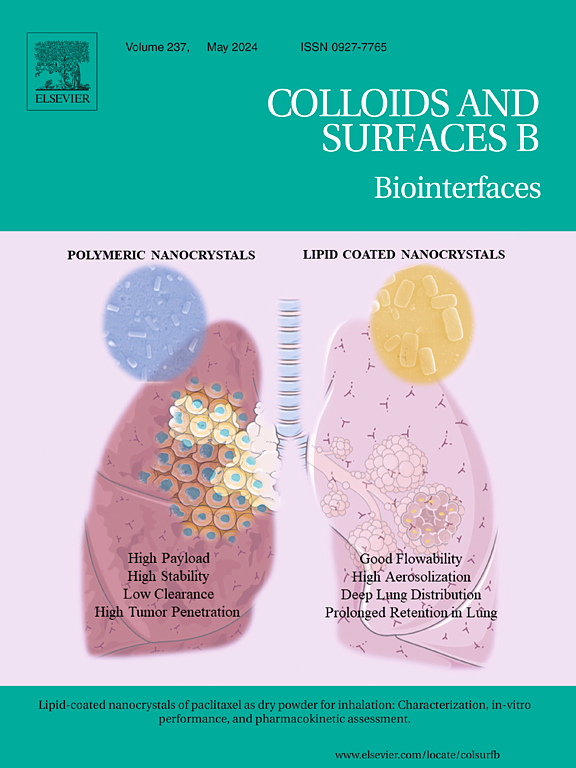苹果皮的疏水性:打蜡和水洗对其与病毒界面相互作用的影响。美国-法国-中国的比较研究
IF 5.4
2区 医学
Q1 BIOPHYSICS
引用次数: 0
摘要
苹果的表面特性,尤其是果皮的疏水性,会影响苹果的保质期和销路。皮肤的表面特性对于确保这种普通消费品的微生物安全也至关重要。目前的工作探讨了如何预售打蜡的包装设施以及消费者的洗涤和储存影响苹果的表面能量,并评估了这种处理对病原菌粘附到苹果表面的影响。基于接触角测量,来自不同地理区域的苹果的表面能被量化,并映射到特定的水果处理场景,包括延长储存时间,以及可能的打蜡和洗涤。利用实验数据计算了苹果皮与人类呼吸道合胞病毒(HRSV)和人类腺病毒5 (HAdV5)这两种对公共卫生有重要意义的致病病毒之间的界面相互作用的自由能。对于美国的富士苹果样品,水洗增加了打蜡苹果的果皮疏水性(ΔG从-60.3 mJ/m2降至- 84.4 mJ/m2),而未打蜡苹果的疏水性更大(ΔG从-53.8 mJ/m2降至- 89.5 mJ/m2)。在贮藏9天内,蜡苹果的疏水性也有所增加(ΔG从-58.0 mJ/m2稳定下降到-94.7 mJ/m2)。对来自美国、中国和法国的苹果进行的比较分析显示,打蜡和水洗的效果有显著差异:打蜡但未水洗的苹果在美国(-60.3 mJ/m2)和中国(-76.5 mJ/m2)都是疏水的,而在法国,同样的处理会产生亲水性表面(34.9 mJ/m2)。作为样本(即既没有打蜡,也没有清洗),来自这三个国家的苹果都是中度疏水性的,可能是由于天然蜡。本研究提供了表面处理、保质期和病毒与苹果相互作用之间的相互作用的见解,旨在改进苹果的食品安全协议和储存实践。本文章由计算机程序翻译,如有差异,请以英文原文为准。
Hydrophobicity of apple skin: Effects of waxing and washing on interfacial interactions with viruses. A comparative U.S.-France-China study
Surface properties of apples, and the hydrophobicity of their skin in particular, affect the shelf life and marketability of apples. Surface characteristics of the skin are also of critical importance for securing microbiological safety of this common consumer item. The present work explores how pre-sale waxing in a packaging facility as well as washing and storage by consumers influence the surface energy of apples and assesses the impact of such treatments on pathogen adhesion to the apple surface. Based on contact angle measurements, the surface energy of apples from different geographical regions was quantified and mapped to specific fruit handling scenarios that included extended storage as well as possible waxing and washing. Experimental data were used as to compute the free energy of interfacial interaction between apple skin and two pathogenic viruses of significant relevance for public health - human respiratory syncytial virus (HRSV) and human adenovirus 5 (HAdV5). For the U.S. samples of Fuji apples, washing increased apple skin hydrophobicity for both apples that were waxed (ΔG decrease from –60.3 mJ/m2 to −84.4 mJ/m2) and, even more, for unwaxed apples (ΔG decrease from –53.8 mJ/m2 to −89.5 mJ/m2). Hydrophobicity of waxed apples also increased (steady decrease in ΔG from –58.0 mJ/m2 to –94.7 mJ/m2) over 9 days of shelf storage. A comparative analysis of apples from the U.S., China, and France revealed notable differences in the effects of waxing and washing: waxed but unwashed apples are hydrophobic in both U.S. (–60.3 mJ/m2) and China (–76.5 mJ/m2), while in France, the same treatment results in a hydrophilic surface (34.9 mJ/m2). As sampled (i. e. neither waxed, nor washed), apples from all three countries are moderately hydrophobic, likely due to natural wax. This study provides insights into the interplay between surface treatments, shelf life, and virus-apple interaction, aiming to improve food safety protocols and storage practices for apples.
求助全文
通过发布文献求助,成功后即可免费获取论文全文。
去求助
来源期刊

Colloids and Surfaces B: Biointerfaces
生物-材料科学:生物材料
CiteScore
11.10
自引率
3.40%
发文量
730
审稿时长
42 days
期刊介绍:
Colloids and Surfaces B: Biointerfaces is an international journal devoted to fundamental and applied research on colloid and interfacial phenomena in relation to systems of biological origin, having particular relevance to the medical, pharmaceutical, biotechnological, food and cosmetic fields.
Submissions that: (1) deal solely with biological phenomena and do not describe the physico-chemical or colloid-chemical background and/or mechanism of the phenomena, and (2) deal solely with colloid/interfacial phenomena and do not have appropriate biological content or relevance, are outside the scope of the journal and will not be considered for publication.
The journal publishes regular research papers, reviews, short communications and invited perspective articles, called BioInterface Perspectives. The BioInterface Perspective provide researchers the opportunity to review their own work, as well as provide insight into the work of others that inspired and influenced the author. Regular articles should have a maximum total length of 6,000 words. In addition, a (combined) maximum of 8 normal-sized figures and/or tables is allowed (so for instance 3 tables and 5 figures). For multiple-panel figures each set of two panels equates to one figure. Short communications should not exceed half of the above. It is required to give on the article cover page a short statistical summary of the article listing the total number of words and tables/figures.
 求助内容:
求助内容: 应助结果提醒方式:
应助结果提醒方式:


